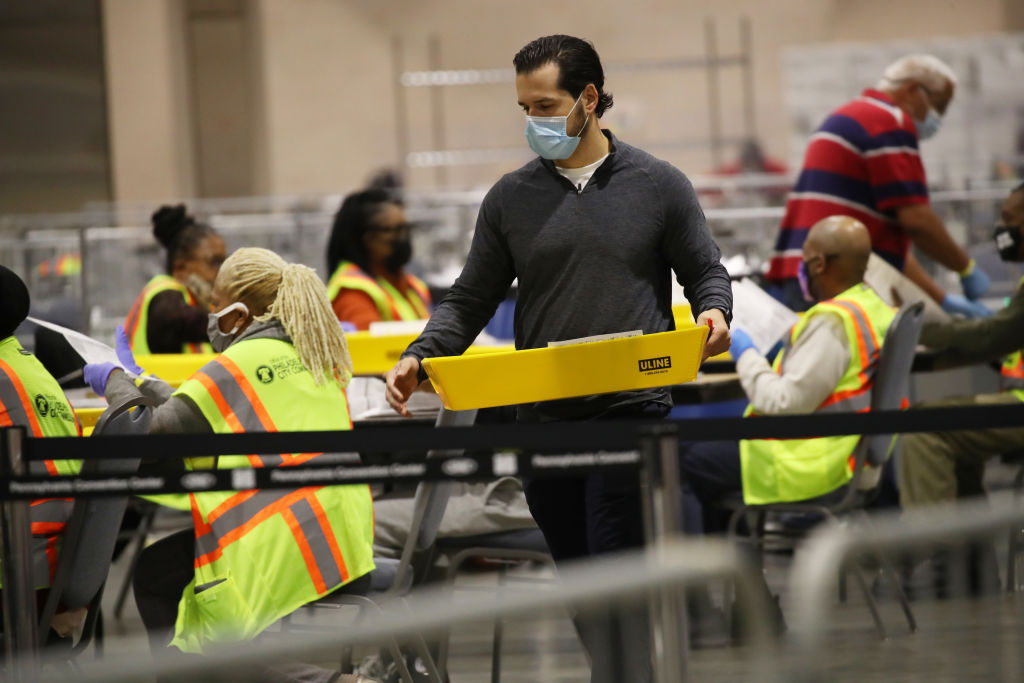Why counting votes in Pennsylvania is taking so long

So Election Day is over, but the election continues.
The world’s attention has turned to a set of swing states still counting important mail-in votes, particularly Pennsylvania. So what exactly is happening today? How are counts happening? Is the election fair and secure?
“I urge everyone to remain patient,” Pennsylvania secretary of state Kathy Boockvar said in a press conference today, “We are going to accurately count every single ballot.”
“The vote count, as I’ve said many times, is never done on the day of election night. The counties are doing this accurately as quickly as they possibly can.”
Across the state, mail-in ballots postmarked on or before Election Day are still arriving—don’t forget there have been significant postal delays—and so counting continues. The Republican state legislature declined to change Pennsylvania law, which meant that processing of over 2.5 million mail-in votes could not begin until Tuesday morning. Other states started the process much earlier.
“The practical labor associated with mail-in ballots has more steps than in-person voting,” says Eddie Perez, a Texas-based election administration expert with the nonpartisan OSET Institute. But, he adds, “Both in human and technology features, there’s a lot of safeguards for mail-in ballots.”
Here’s a concise but thorough rundown of the counting, security, and integrity process right now in Pennsylvania:
- Ballots and envelopes were sent out only to registered and verified voters who requested them.
- Election officials receive the ballot and envelope within three days of Election Day—although this deadline may be challenged by Republicans.
- Officials verify that each ballot is associated with the exact eligible voter on the rolls.
- Ballots are validated with voter records in exactly the same way as in-person votes.
- To prevent fraud, each ballot and envelope has computer-readable codes and precise physical features like style, size, weight, and design that allow the computers to associate them with specific elections, precincts, content, and additional validation information.
- Signatures on the ballot envelopes are matched against a central database by bipartisan teams.
- Envelopes are opened and paperwork removed in a specific and legally mandated procedure.
- Ballots that fail to pass these security measures are sent for further investigation, or for follow-up with the voter.
Decades of history, independent study, and these extra security steps explain why mail-in ballots are not easily susceptible to fraud, and why attempts to paint them as such are baseless disinformation, a false narrative propagated first and foremost by the president of the United States. In decades of increasing mail-in voting around the United States, widespread fraud has been nonexistent.
The Trump campaign, having now lost in the key swing state of Wisconsin, has said it will sue in Michigan and Pennsylvania to stop the ongoing counting of ballots, while falsely claiming victory even as many votes still remain uncounted. Votes counted earlier in the process favor Trump, while the mail-in votes from Democratic areas that are still being counted are expected to favor Biden.
The counting in Pennsylvania could carry on through Friday.
There is one more scenario to address. Pennsylvania automatically recounts votes if the result is within 0.5%. A loser can request and pay for a recount by going to court and alleging errors in the vote count.
So far there is no reason to believe any such errors have occurred, but as has been said so many times, there is still a long way to go in Pennsylvania—and that means there may still be a long way to go for everyone.
This is an excerpt from The Outcome, our daily email on election integrity and security. Click here to get regular updates straight to your inbox.
Deep Dive
Computing
How ASML took over the chipmaking chessboard
MIT Technology Review sat down with outgoing CTO Martin van den Brink to talk about the company’s rise to dominance and the life and death of Moore’s Law.
How Wi-Fi sensing became usable tech
After a decade of obscurity, the technology is being used to track people’s movements.
Why it’s so hard for China’s chip industry to become self-sufficient
Chip companies from the US and China are developing new materials to reduce reliance on a Japanese monopoly. It won’t be easy.
Stay connected
Get the latest updates from
MIT Technology Review
Discover special offers, top stories, upcoming events, and more.